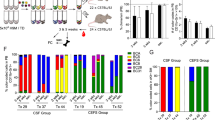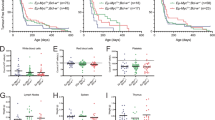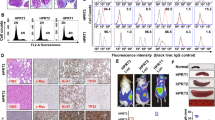Abstract
The cell of origin of tumors and the factors determining the cell of origin remain unclear. In this study, a mouse model of precursor B acute lymphoblastic leukemia/lymphoma (pre-B ALL/LBL) was established by retroviral transduction of Myc genes (N-Myc or c-Myc) into mouse bone marrow cells. Hematopoietic stem cells (HSCs) exhibited the highest susceptibility to N-Myc-induced pre-B ALL/LBL versus lymphoid progenitors, myeloid progenitors and committed progenitor B cells. N-Myc was able to induce pre-B ALL/LBL directly from progenitor B cells in the absence of Ink4a and Arf. Arf was expressed higher in progenitor B cells than Ink4a. In addition, N-Myc induced pre-B ALL/LBL from Arf−/− progenitor B cells suggesting that Arf has a predominant role in determining the cell of origin of pre-B ALL/LBL. Tumor cells derived from Ink4a/Arf−/− progenitor B cells exhibited a higher rate of proliferation and were more chemoresistant than those derived from wild-type HSCs. Furthermore, the Mdm2 inhibitor Nutlin-3 restored p53 and induced massive apoptosis in mouse pre-B ALL/LBL cells derived from Ink4a/Arf−/− cells and human B-ALL cell lines lacking Ink4a and Arf expression, suggesting that Mdm2 inhibition may be a novel therapeutic approach to the treatment of Ink4a/Arf−/− B-ALL/LBL, such as is frequently found in Ph+ ALL and relapsed ALL. Collectively, these findings indicate that Ink4a and Arf are critical determining factors of the cell of origin and the therapeutic sensitivity of Myc-induced lymphoid tumors.
This is a preview of subscription content, access via your institution
Access options
Subscribe to this journal
Receive 50 print issues and online access
$259.00 per year
only $5.18 per issue
Buy this article
- Purchase on Springer Link
- Instant access to full article PDF
Prices may be subject to local taxes which are calculated during checkout







Similar content being viewed by others
References
Adams JM, Harris AW, Pinkert CA, Corcoran LM, Alexander WS, Cory S et al. (1985). The c-myc oncogene driven by immunoglobulin enhancers induces lymphoid malignancy in transgenic mice. Nature 318: 533–538.
Ausserlechner MJ, Obexer P, Wiegers GJ, Hartmann BL, Geley S, Kofler R . (2001). The cell cycle inhibitor p16(INK4A) sensitizes lymphoblastic leukemia cells to apoptosis by physiologic glucocorticoid levels. J Biol Chem 276: 10984–10989.
Calabretta B, Perrotti D . (2004). The biology of CML blast crisis. Blood 103: 4010–4022.
Cano F, Pannel R, Follows GA, Rabbitts TH . (2008). Preclinical modeling of cytosine arabinoside response in Mll-Enl translocator mouse leukemias. Mol Cancer Ther 7: 730–735.
Cardone M, Kandilci A, Carella C, Nilsson JA, Brennan JA, Sirma S et al. (2005). The novel ETS factor TEL2 cooperates with Myc in B lymphomagenesis. Mol Cell Biol 25: 2395–2405.
Castor A, Nilsson L, Astrand-Grundstrom I, Buitenhuis M, Ramirez C, Anderson K et al. (2005). Distinct patterns of hematopoietic stem cell involvement in acute lymphoblastic leukemia. Nat Med 11: 630–637.
Cobaleda C, Gutierrez-Cianca N, Perez-Losada J, Flores T, Garcia-Sanz R, Gonzalez M et al. (2000). A primitive hematopoietic cell is the target for the leukemic transformation in human Philadelphia-positive acute lymphoblastic leukemia. Blood 95: 1007–1013.
Cobaleda C, Sanchez-Garcia I . (2009). B-cell acute lymphoblastic leukaemia: towards understanding its cellular origin. Bioessays 31: 600–609.
Cox CV, Evely RS, Oakhill A, Pamphilon DH, Goulden NJ, Blair A . (2004). Characterization of acute lymphoblastic leukemia progenitor cells. Blood 104: 2919–2925.
Eischen CM, Weber JD, Roussel MF, Sherr CJ, Cleveland JL . (1999). Disruption of the ARF-Mdm2-p53 tumor suppressor pathway in Myc-induced lymphomagenesis. Genes Dev 13: 2658–2669.
Gu L, Zhu N, Findley HW, Zhou M . (2008). MDM2 antagonist nutlin-3 is a potent inducer of apoptosis in pediatric acute lymphoblastic leukemia cells with wild-type p53 and overexpression of MDM2. Leukemia 22: 730–739.
Hemann MT, Bric A, Teruya-Feldstein J, Herbst A, Nilsson JA, Cordon-Cardo C et al. (2005). Evasion of the p53 tumour surveillance network by tumour-derived MYC mutants. Nature 436: 807–811.
Hong D, Gupta R, Ancliff P, Atzberger A, Brown J, Soneji S et al. (2008). Initiating and cancer-propagating cells in TEL-AML1-associated childhood leukemia. Science 319: 336–339.
Hotfilder M, Rottgers S, Rosemann A, Schrauder A, Schrappe M, Pieters R et al. (2005). Leukemic stem cells in childhood high-risk ALL/t(9;22) and t(4;11) are present in primitive lymphoid-restricted CD34+CD19- cells. Cancer Res 65: 1442–1449.
Hu Y, Smyth GK . (2009). ELDA: extreme limiting dilution analysis for comparing depleted and enriched populations in stem cell and other assays. J Immunol Methods 347: 70–78.
Iwama A, Oguro H, Negishi M, Kato Y, Morita Y, Tsukui H et al. (2004). Enhanced self-renewal of hematopoietic stem cells mediated by the polycomb gene product Bmi-1. Immunity 21: 843–851.
Jacobs JJ, Scheijen B, Voncken JW, Kieboom K, Berns A, van Lohuizen M . (1999). Bmi-1 collaborates with c-Myc in tumorigenesis by inhibiting c-Myc-induced apoptosis via INK4a/ARF. Genes Dev 13: 2678–2690.
Kamijo T, Zindy F, Roussel MF, Quelle DE, Downing JR, Ashmun RA et al. (1997). Tumor suppression at the mouse INK4a locus mediated by the alternative reading frame product p19ARF. Cell 91: 649–659.
Kawagoe H, Kandilci A, Kranenburg TA, Grosveld GC . (2007). Overexpression of N-Myc rapidly causes acute myeloid leukemia in mice. Cancer Res 67: 10677–10685.
Kojima K, Konopleva M, McQueen T, O'Brien S, Plunkett W, Andreeff M . (2006). Mdm2 inhibitor Nutlin-3a induces p53-mediated apoptosis by transcription-dependent and transcription-independent mechanisms and may overcome Atm-mediated resistance to fludarabine in chronic lymphocytic leukemia. Blood 108: 993–1000.
Kojima K, Konopleva M, Samudio IJ, Shikami M, Cabreira-Hansen M, McQueen T et al. (2005). MDM2 antagonists induce p53-dependent apoptosis in AML: implications for leukemia therapy. Blood 106: 3150–3159.
le Viseur C, Hotfilder M, Bomken S, Wilson K, Rottgers S, Schrauder A et al. (2008). In childhood acute lymphoblastic leukemia, blasts at different stages of immunophenotypic maturation have stem cell properties. Cancer Cell 14: 47–58.
Luo H, Li Q, O'Neal J, Kreisel F, Le Beau MM, Tomasson MH . (2005). c-Myc rapidly induces acute myeloid leukemia in mice without evidence of lymphoma-associated antiapoptotic mutations. Blood 106: 2452–2461.
Meyer N, Penn LZ . (2008). Reflecting on 25 years with MYC. Nat Rev Cancer 8: 976–990.
Morita S, Kojima T, Kitamura T . (2000). Plat-E: an efficient and stable system for transient packaging of retroviruses. Gene Ther 7: 1063–1066.
Morse III HC, Anver MR, Fredrickson TN, Haines DC, Harris AW, Harris NL et al. (2002). Bethesda proposals for classification of lymphoid neoplasms in mice. Blood 100: 246–258.
Mullighan CG, Phillips LA, Su X, Ma J, Miller CB, Shurtleff SA et al. (2008a). Genomic analysis of the clonal origins of relapsed acute lymphoblastic leukemia. Science 322: 1377–1380.
Mullighan CG, Williams RT, Downing JR, Sherr CJ . (2008b). Failure of CDKN2A/B (INK4A/B-ARF)-mediated tumor suppression and resistance to targeted therapy in acute lymphoblastic leukemia induced by BCR-ABL. Genes Dev 22: 1411–1415.
Park IK, Qian D, Kiel M, Becker MW, Pihalja M, Weissman IL et al. (2003). Bmi-1 is required for maintenance of adult self-renewing haematopoietic stem cells. Nature 423: 302–305.
Schmitt CA, Fridman JS, Yang M, Lee S, Baranov E, Hoffman RM et al. (2002). A senescence program controlled by p53 and p16INK4a contributes to the outcome of cancer therapy. Cell 109: 335–346.
Schmitt CA, McCurrach ME, de Stanchina E, Wallace-Brodeur RR, Lowe SW . (1999). INK4a/ARF mutations accelerate lymphomagenesis and promote chemoresistance by disabling p53. Genes Dev 13: 2670–2677.
Shimizu T, Ishikawa T, Sugihara E, Kuninaka S, Miyamoto T, Mabuchi Y et al. (2010). c-MYC overexpression with loss of Ink4a/Arf transforms bone marrow stromal cells into osteosarcoma accompanied by loss of adipogenesis. Oncogene 29: 5687–5699.
Sugihara E, Kanai M, Saito S, Nitta T, Toyoshima H, Nakayama K et al. (2006). Suppression of centrosome amplification after DNA damage depends on p27 accumulation. Cancer Res 66: 4020–4029.
Tsuji K, Mizumoto K, Sudo H, Kouyama K, Ogata E, Matsuoka M . (2002). p53-independent apoptosis is induced by the p19ARF tumor suppressor. Biochem Biophys Res Commun 295: 621–629.
Vassilev LT, Vu BT, Graves B, Carvajal D, Podlaski F, Filipovic Z et al. (2004). In vivo activation of the p53 pathway by small-molecule antagonists of MDM2. Science 303: 844–848.
Visvader JE . (2011). Cells of origin in cancer. Nature 469: 314–322.
Wade M, Wang YV, Wahl GM . (2010). The p53 orchestra: Mdm2 and Mdmx set the tone. Trends Cell Biol 20: 299–309.
Wang PY, Young F, Chen CY, Stevens BM, Neering SJ, Rossi RM et al. (2008). The biologic properties of leukemias arising from BCR/ABL-mediated transformation vary as a function of developmental origin and activity of the p19ARF gene. Blood 112: 4184–4192.
Wilson A, Murphy MJ, Oskarsson T, Kaloulis K, Bettess MD, Oser GM et al. (2004). c-Myc controls the balance between hematopoietic stem cell self-renewal and differentiation. Genes Dev 18: 2747–2763.
Yasuda T, Sanjo H, Pages G, Kawano Y, Karasuyama H, Pouyssegur J et al. (2008). Erk kinases link pre-B cell receptor signaling to transcriptional events required for early B cell expansion. Immunity 28: 499–508.
Acknowledgements
We thank I Ishimatsu, Y Hata and S Suzuki for technical assistance, K Arai for help in the preparation of the manuscript, CJ Sherr (St Jude Children's Research Hospital) for providing Arf−/− mice, Dr A Kenny (Memorial Sloan-Kettering Cancer Center) for providing the N-Myc cDNA, Dr T Kitamura (The University of Tokyo) for providing the retroviral vector pMXs-IG and Plat-E cells and Dr A Iwama (Chiba University) for providing the Bmi1 cDNA. This work was supported by grant-in-Aid for Scientific Research from the Ministry of Education, Culture, Sports, Science and Technology of Japan (HS) and the US National Institutes of Health CA55164, CA136411 and CA100632 (MA).
Author information
Authors and Affiliations
Corresponding author
Ethics declarations
Competing interests
Dr Andreeff’s work is supported by grants from the NIH and by Hoffmann-La Roche, Nutley, NJ.
Additional information
Supplementary Information accompanies the paper on the Oncogene website
Supplementary information
Rights and permissions
About this article
Cite this article
Sugihara, E., Shimizu, T., Kojima, K. et al. Ink4a and Arf are crucial factors in the determination of the cell of origin and the therapeutic sensitivity of Myc-induced mouse lymphoid tumor. Oncogene 31, 2849–2861 (2012). https://doi.org/10.1038/onc.2011.462
Received:
Revised:
Accepted:
Published:
Issue Date:
DOI: https://doi.org/10.1038/onc.2011.462
Keywords
This article is cited by
-
Chemotherapy-induced niche perturbs hematopoietic reconstitution in B-cell acute lymphoblastic leukemia
Journal of Experimental & Clinical Cancer Research (2018)
-
Fasting selectively blocks development of acute lymphoblastic leukemia via leptin-receptor upregulation
Nature Medicine (2017)
-
Hair follicle–derived IL-7 and IL-15 mediate skin-resident memory T cell homeostasis and lymphoma
Nature Medicine (2015)
-
The ITIM-containing receptor LAIR1 is essential for acute myeloid leukaemia development
Nature Cell Biology (2015)
-
Inhibitory leukocyte immunoglobulin-like receptors in cancer development
Science China Life Sciences (2015)



